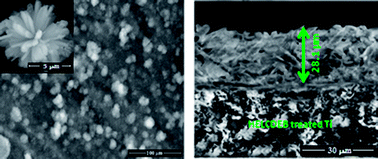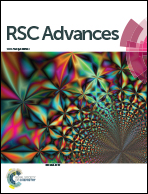Retracted Article: Investigation on corrosion protection and mechanical performance of minerals substituted hydroxyapatite coating on HELCDEB-treated titanium using pulsed electrodeposition method
Abstract
The present work aims to investigate the effects of minerals (strontium, magnesium and zinc) substituted hydroxyapatite (M-HAP) coating on high-energy low-current DC electron beam (HELCDEB)-treated titanium (Ti). The M-HAP coating was developed over the untreated and HELCDEB-treated Ti by pulsed electrodeposition, and was characterized by scanning electron microscopy, X-ray diffraction, Fourier transform infrared spectroscopy, Raman spectroscopy, X-ray photoelectron spectroscopy and electrochemical techniques. The M-HAP coating was obtained on Ti treated at 500 and 700 keV HELCDEB. The coating on the 700 keV HELCDEB-treated Ti showed better corrosion resistance properties than the coating obtained on the 500 keV HELCDEB-treated and untreated Ti. The M-HAP coating on the HELCDEB-treated Ti showed typical flower-like morphology, and exhibited better resistance to corrosion in simulated body fluid (SBF), along with increased microhardness and decreased contact angle. An in vitro study of the coating was conducted by immersion in the SBF solution for 1–7 days. The results clearly showed that the M-HAP coating on 700 keV HELCDEB-treated Ti enhanced its corrosion resistivity and mechanical properties. The coating may have many applications in orthopedics because it could improve implant fixation in human bone.


 Please wait while we load your content...
Please wait while we load your content...